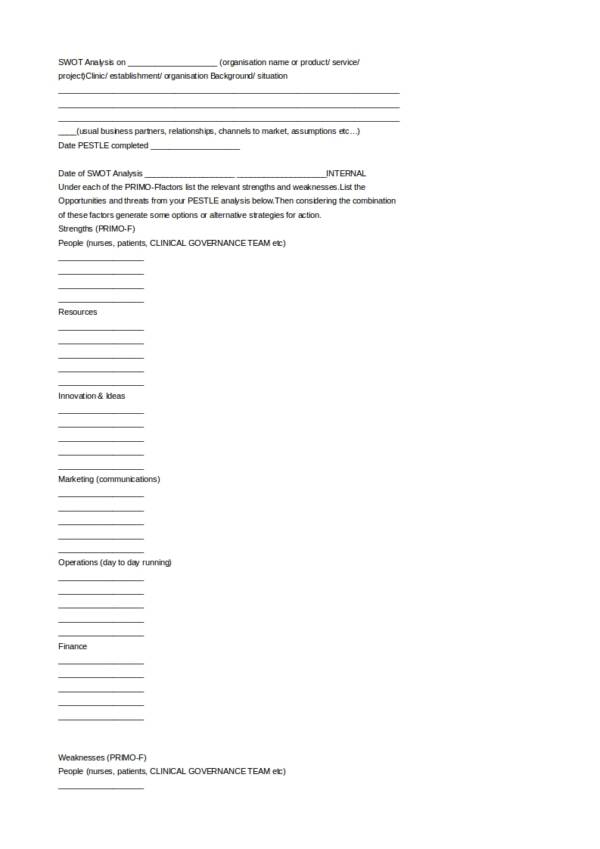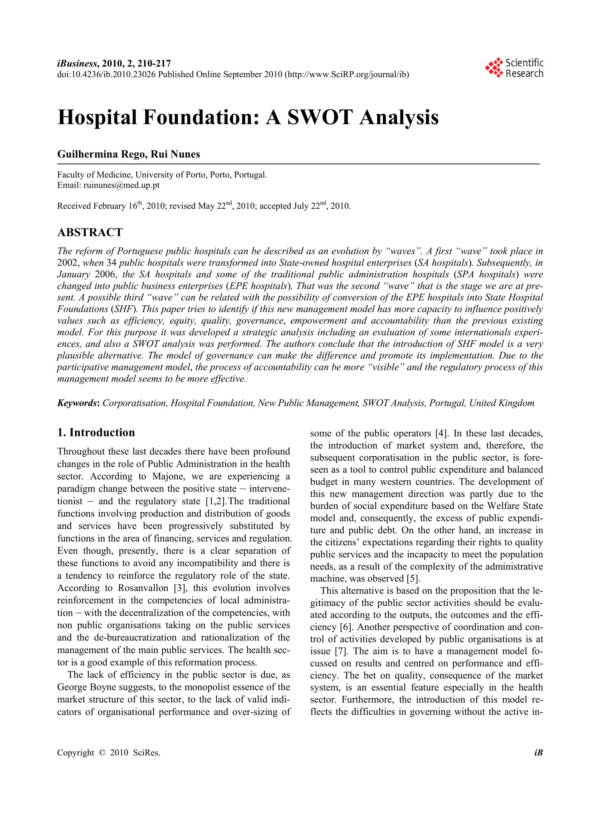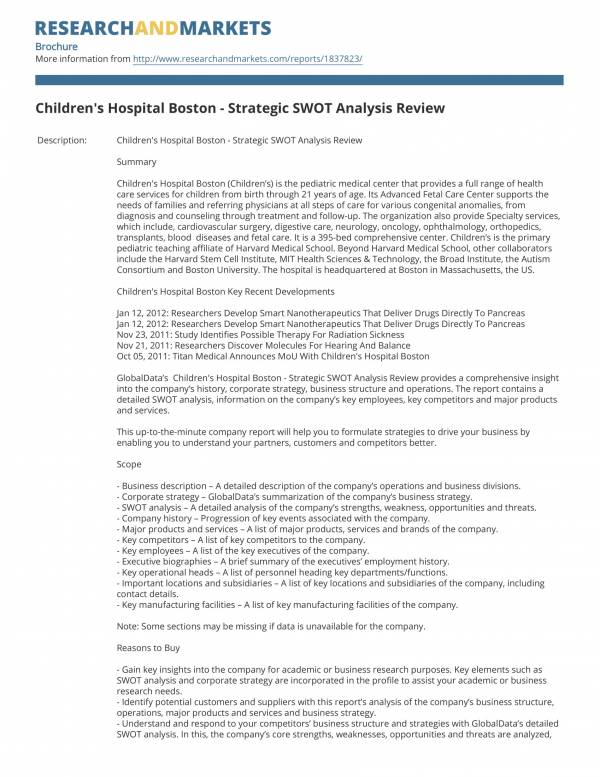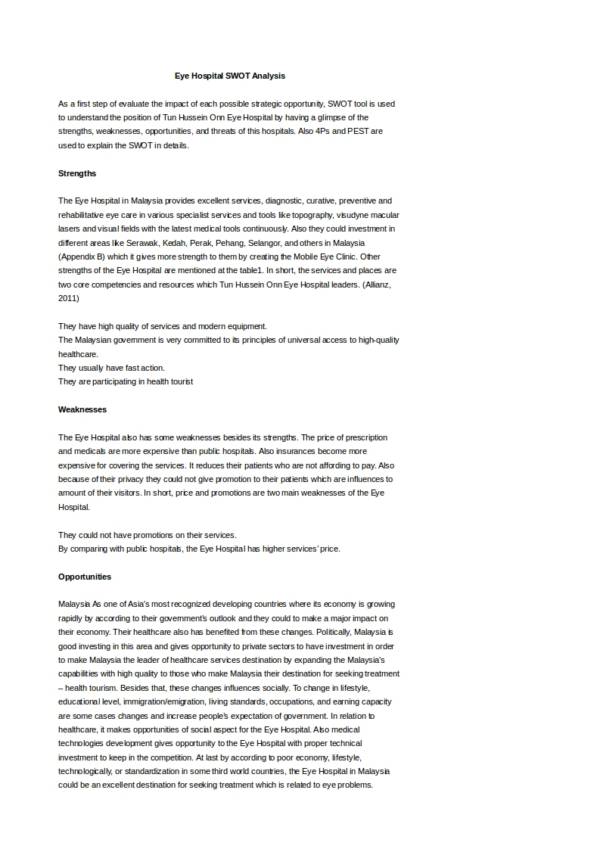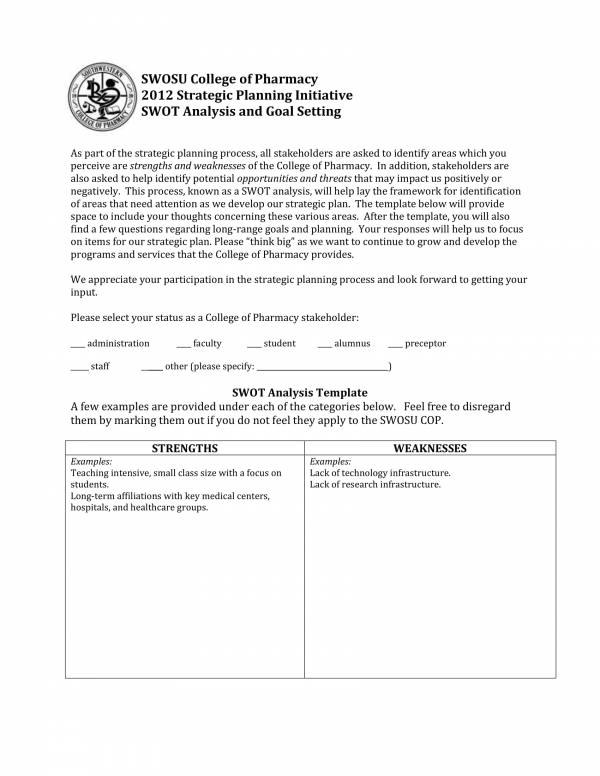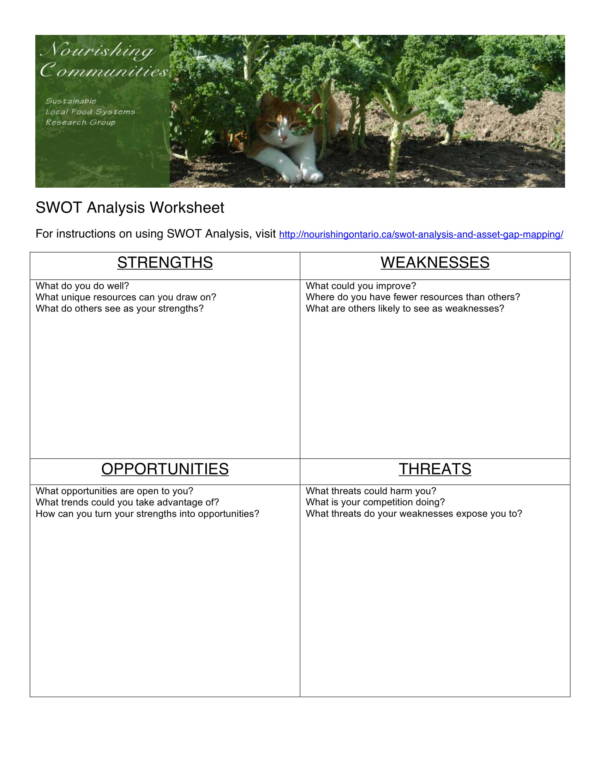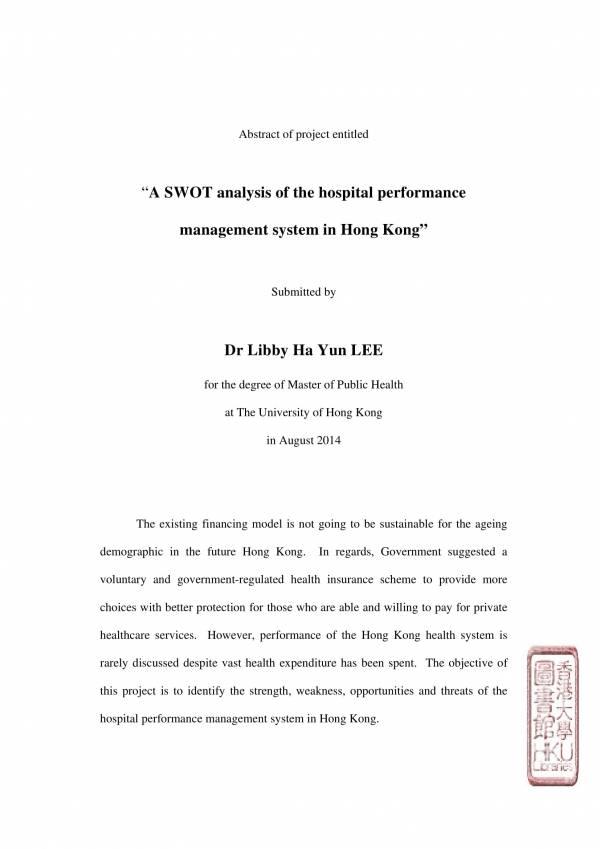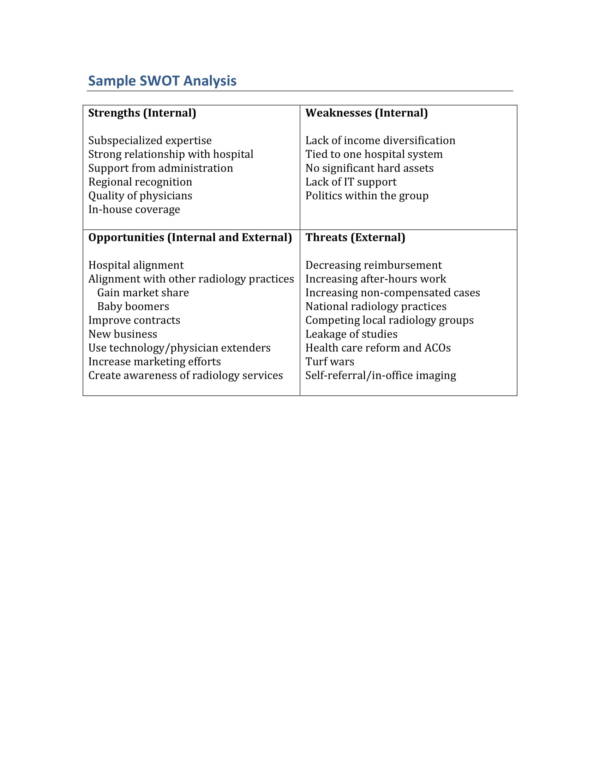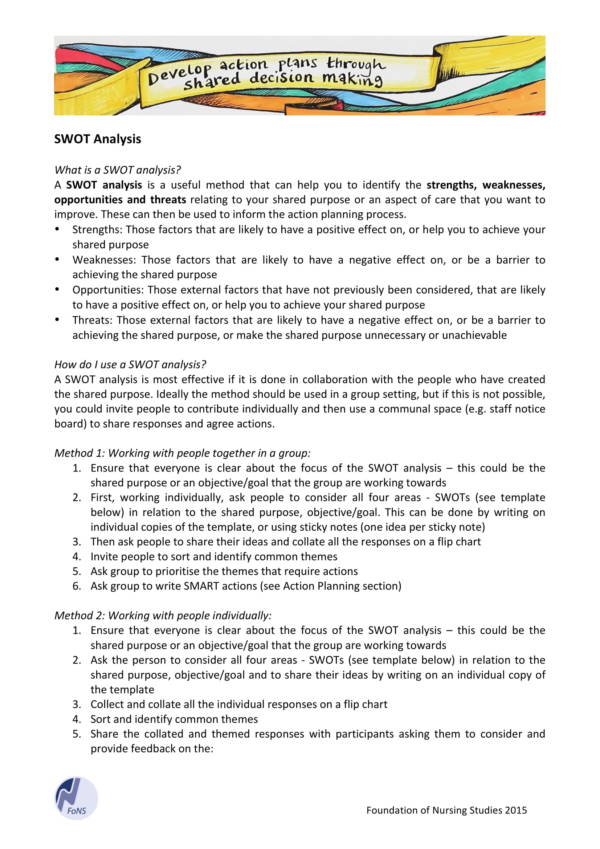SWOT stands for strengths, weakness, opportunities and threats and this makes up a strategic plan that is popularly known as a SWOT analysis. A SWOT analysis allows an individual or organization become aware of their strengths and weaknesses, as well as discover the opportunities that are ahead of them and also be able to avoid or prevent threats from happening.
Hospitals and other health institutions make use of a SWOT analysis to gather data that is essential for the institution. Although it is not commonly used in the hospital setting or in health care institutions, it has now gained acknowledgement and is slowly being integrated to the strategic planning in these institutions. We have here hospital SWOT analysis samples and templates that you can use as reference. Check them out below.
Hospital SWOT Analysis Sample

SWOT Analysis Sample for Hospital
Hospital Foundation SWOT Analysis
SWOT Analysis For a Children’s Hospital
Eye Hospital SWOT Analysis
SWOT Analysis and Goal Setting Template
Uses of a SWOT Analysis in the Hospital
If you have been to a hospital or perhaps worked in the hospital setting, then you would probably have an idea on what a SWOT analysis in the hospital is used for. Here are some of the uses of a SWOT analysis.
- The main use of a SWOT analysis is to help hospital institutions realize and identify their strengths and weaknesses so that they can make the most out of it and find ways on how to effectively resolve or get rid of their weaknesses.
- Being able to determine the opportunities that one has is essential in the decision making process. It is because it can be used as a basis for which action is best taken by he institution.
- Hospital institutions aim to provide quality care and state of he art services through means accessible to them and to their clients. Finding a way in how they could have it done can be made easy with the use of a SWOT analysis.
- A SWOT analysis allows hospital institutions to identify gaps in medical and nursing care, which allows them to create a process or a solution to make the care provided better.
- When it comes to formulating goals and objectives, the results of a SWOT analysis can be used as a basis for what the hospital really has to deal with along with the best course of action.
- A SWOT analysis is also useful in building organizational or personal strategies as well as provide steps in executing the said strategy. This is because it is able to point out internal and external factors.
- When a threat is encountered, a SWOT analysis can also be used as a basis for a defensive strategy.
- A SWOT analysis is used to match the hospital institutions strengths to the opportunities available to them. This is helps the institution gain advantage over their competitors.
- Another use of a SWOT analysis is converting weaknesses and threats into strengths or opportunities of the institution. With thorough analyzation and proper planning, this conversion process can be made possible.
- Hospital institutions, especially private hospitals, need to promote themselves in order to have more clients coming in. These clients will be their source of profit. A SWOT analysis would be a good tool to use as reference when creating a marketing plan or strategy to help promote the institution and its facilities.
There are quite a lot of uses of a SWOT analysis aside from hospitals and other health care institutions. This just shows that it is an indispensable tool. To learn more about SWOT analysis and other related articles, you may check them out on our website. Some titles we offer are Health Care SWOT Analysis Samples and Templates and Restaurant SWOT Analysis Samples & Templates.
What Are the Advantages and Disadvantages of a SWOT Analysis?
A SWOT analysis is very useful and has proven itself effective in a lot of different industries, firms and organizations. It is not only used in money making or profit-seeking organizations, but its use has become popular in a variety of fields or situations. With that being said, there are certain advantages and disadvantages with the use of a SWOT analysis. Let us go ahead and find out what they are.
Advantages:
- A SWOT analysis is a simple tool that does not require any special training or years of experience to get done. What is required from an individual to be able to work on it is knowledge about their work or organization so that they can provide an output that is useful and effective.
- There are not a lot of things needed in a SWOT analysis. There are only four components that needs to be identified and they are strengths, weaknesses, opportunities and threats. This way it be quick and easy for anyone to conduct.
- The presentation of the data gathered also does not require any special or specific format. It can be presented however the organization wants it to provided that it is easy to read and understandable.
- A SWOT analysis is worked on and involves different individuals within the organization, which means that every member gets a chance to provide their opinion. Different outputs mean that they have a lot of choices to choose from.
- It helps an individual or organization become aware of their strengths, weaknesses, opportunities and threats which they can analyze and use to their advantage.
- Not only is it used to help awareness, a SWOT analysis is also used as a basis for decision making, risks or crisis management, and pre-crisis planning.
- Conducting a SWOT analysis will allow you save time and money as the process is never costly and is guaranteed effective.
Disadvantages:
- Who conducts a SWOT analysis? It is actually conducted by any knowledgeable member of the organization. This means that the data provided is subjected and are solely based on the observations of a single individual. Therefore, care should be taken in selecting an evaluator and the data gathered should be scrutinized.
- There are no means of measuring the weight of each component in a SWOT analysis as there are no given set of standards for it.
- Prioritization is not part of the components of a SWOT analysis so the evaluator does not take that into consideration. Prioritization must be done or applied when data is analyzed.
- The evaluator should understand what they are doing and what they are looking for in order to gather the desired data or information.
- It does not offer you any solutions to problems or threats that your organization might be facing. All it does it provide you with a list of details of its strengths, weaknesses, opportunities and threats. This means that there are limitations to what you can do with a SWOT analysis.
The advantages of a SWOT analysis truly outnumbered its disadvantages. This gives us more reason to use the tool compared to anything else. You may also want to check out other topics, like industry analysis samples and business SWOT analysis samples.
How to Do a SWOT Analysis
It is pretty simple and easy to make a SWOT analysis. Here, we will provide you with easy-to-follow steps on how to do it.
- First, gather the data or information that will be needed for the analysis. Make sure that you are able to get all of the relevant and important information as this will determine the usefulness and effectiveness of the results of your analysis.
- Use guide questions to help you gather the information that you need for the SWOT analysis you will be doing.
- You will need a template where you will be writing down all of your finding or where you will be recording your observations and other gathered data. There are many downloadable SWOT analysis templates online that you can use. They are also mostly for free.
- Now, you will need to categorize the information or data that you have gathered. Write them down in their corresponding categories if they are strengths, weakness, opportunities or threats. This will allow you to have an organized list of data and also enables you to easily browse through them.
- Review your work. Make sure that everything is in place.
- Now, analyze the data that you have gathered and then use it as your basis for making decisions that are related and useful to the organization.
If you are having a hard time doing a SWOT analysis, especially if it is your first time, then that is fine. You just need more practice and a little getting used to. You will become better if you try. Other related articles that you may be interested in are financial analysis samples and marketing analysis samples.
Health Care SWOT Analysis Template With Instructions
Hospital Sample SWOT Analysis
Sample SWOT Analysis Template
Editable Hospital SWOT Analysis
Nursing SWOT Analysis Template With Guide Questions
Tips In Making A SWOT Analysis
So what can you do to make your SWOT analysis better and more effective aside from trying and practicing? Well, you can use these simple and easy tips that we have listed below. Don’t struggle because they are indeed easy.
- Use guide questions when gathering your data or information. You will be able to gather important details rather than getting random information.
- You can also write your own guide questions before you start. This way you will know what you need to do to complete the task.
- Write clearly and concisely. As much as possible, use simple words for your findings. This will avoid confusion and creation of a lot of misinterpretation of the data you have gathered.
- Arrange the information that you have gathered in a way that is easy to read and understand. You can use a printable template for your convenience.
These tips may be simple, but they will surely help you get things done. We hope that you are able to learn from this article. You may also use the samples and templates that we have provided however you want.
Related Posts
FREE 10+ Failure Mode and Effects Analysis Samples in PDF
FREE 10+ Make or Buy Analysis Samples in PDF
FREE 10+ Fishbone Root Cause Analysis Samples in PDF
FREE 11+ Cost Volume Profit Analysis Samples & Templates in PDF | MS Word
FREE 6+ Corporate Portfolio Analysis Samples in PDF
FREE 10+ Fault Tree Analysis Samples in PDF
FREE 10+ Comp Analysis Samples in PDF
FREE 10+ Fishbone Analysis Samples in PDF
FREE 10+ Individual Swot Analysis Samples in PDF
FREE 10+ 5 Year Analysis Samples in PDF
FREE 10+ Benefit Costs Analysis Samples in PDF
FREE 10+ Job Hazard Analysis Samples in PDF
FREE 10+ Primary Source Analysis Samples in PDF
FREE 10+ Critical Path Analysis Samples in PDF
FREE 10+ Competition Analysis Samples in PDF

